Novavax, no boom in new vaccines. Gimbe Report
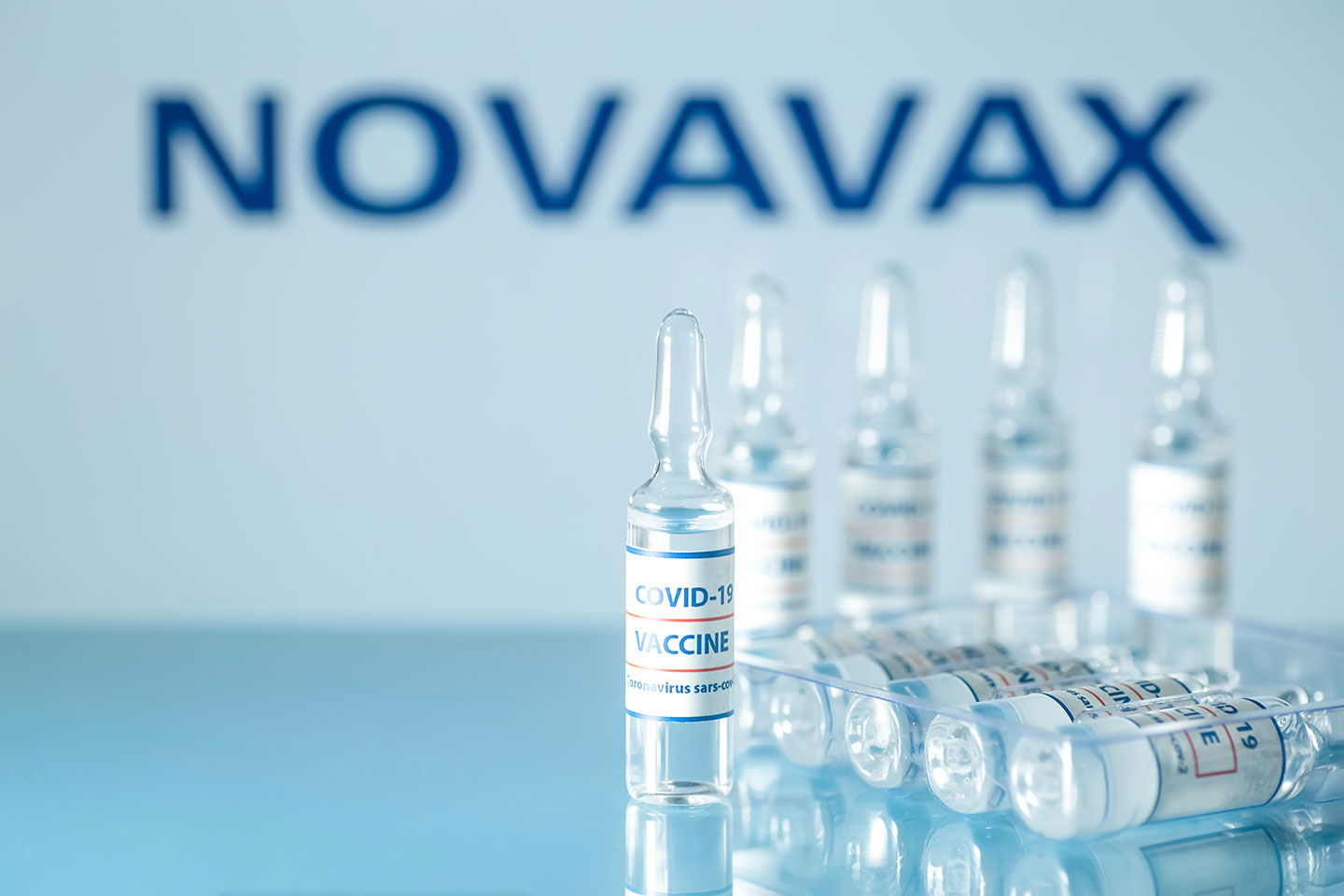
Novavax does not take off, only 11,595 doses have been administered so far. Deaths and hospitalizations continue to decrease but there is a slight increase in new infections. What emerges from the latest report from the Gimbe Foundation
Disappointment for the unvaccinated who have not responded to the call even with the arrival of Nuvaxovid , the Novavax vaccine based on a more traditional technology than the innovative second generation mRna vaccines.
Furthermore, the first administrations in the 5-11 range also dropped further (-50.1%). This was reported by the Gimbe Foundation which, like every week, monitors the progress of the pandemic in Italy.
NOVAVAX DOES NOT TAKE OFF
“The hope that this vaccine, based on a more traditional technology than the innovative mRna vaccines, could convince the undecided was rejected. Unfortunately, on the front of the new vaccinated, there is no boom ”, points out the president Gimbe Nino Cartabellotta.
DATA ON THE ADMINISTRATIONS OF NOVAVAX
Since February 28, according to the report prepared by the Foundation, 11,595 doses of Novavax have been administered, of which 59.2% in people over 50, most of them of working age.
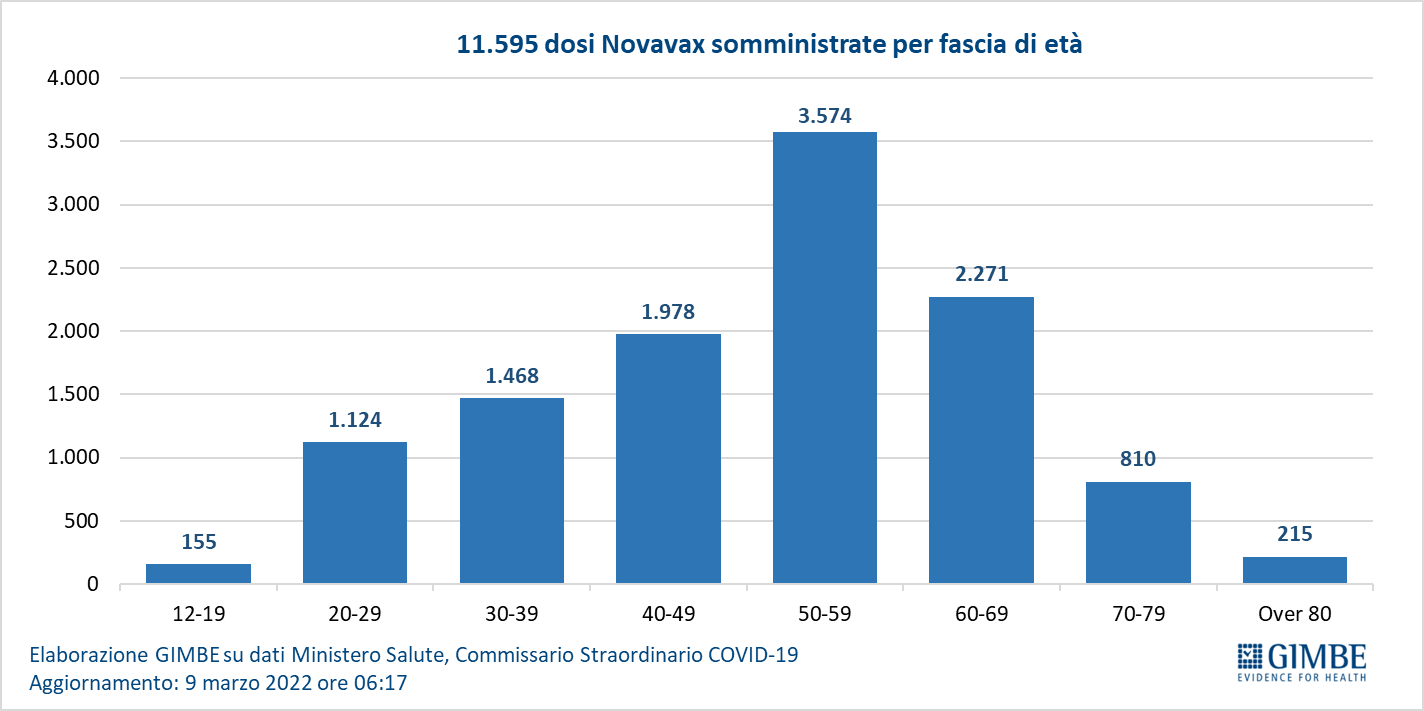
HOW MANY ARE THE NEW VACCINATES
In the week 2-8 March, Gimbe said, there was a further decline in new vaccinated: 29,474 compared to 39,036 the previous week (-24.5%). Of these, 17.9% is represented by the 5-11 bracket: 5,290, a number halved compared to the previous week (-50.1%).
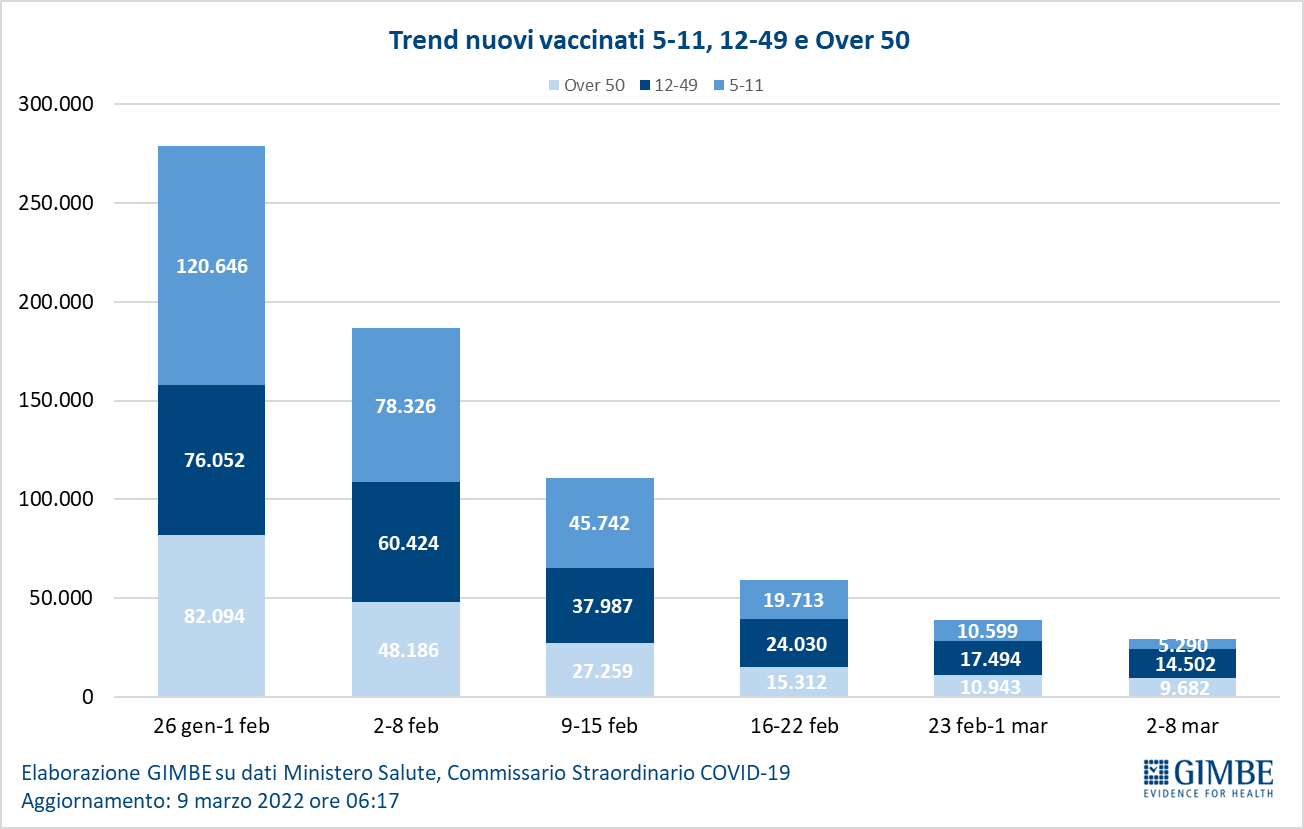
Despite the vaccination obligation and the reinforced green pass obligation in the workplace, among the over 50s the number of new vaccinated people drops again, reaching 9,682 (-11.5% compared to the previous week).
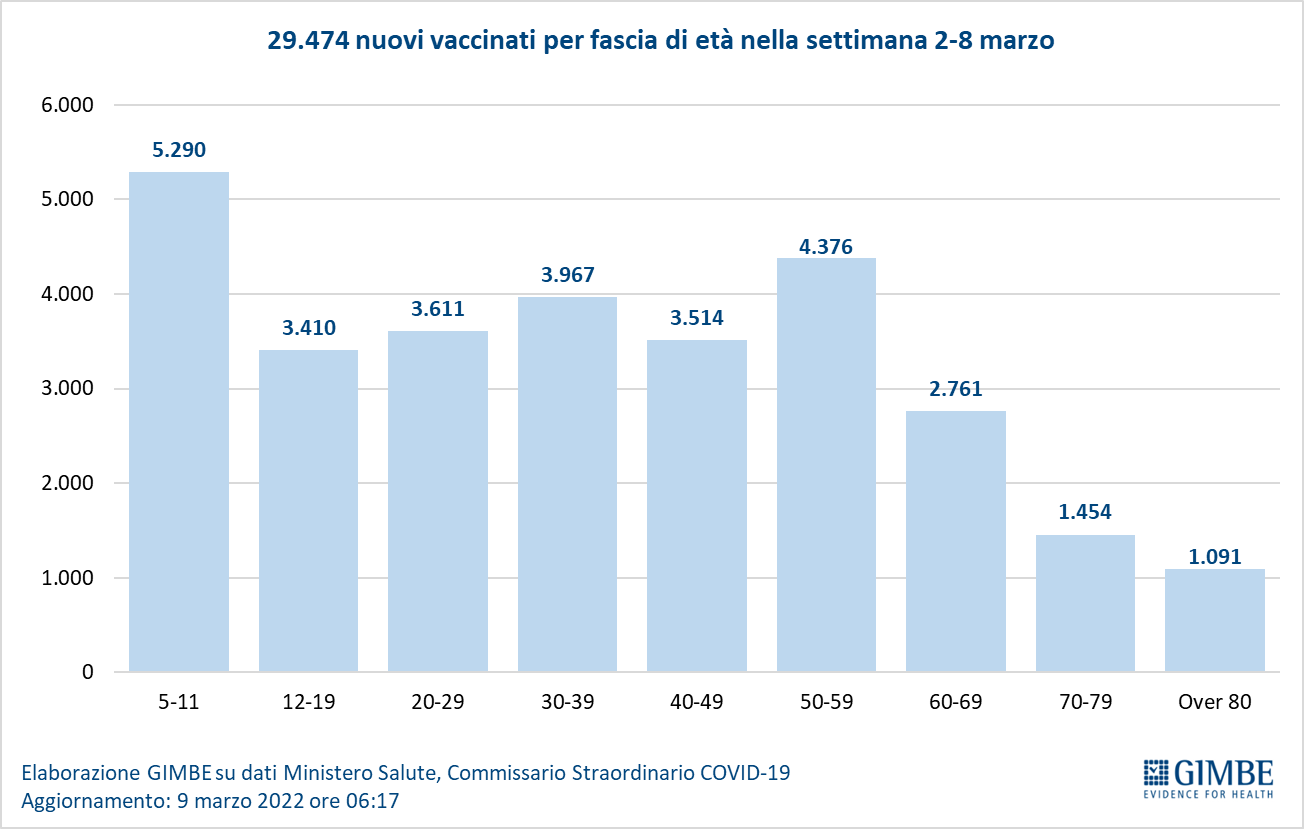
AT WHAT POINT IS THE VACCINAL CAMPAIGN
As of March 9, 85.5% of the population (n. 50,658,027) received at least one dose of vaccine (+19,150 compared to the previous week) and 83.6% (n. 49,534,941) completed the vaccination cycle (+137.230 compared to the previous week).
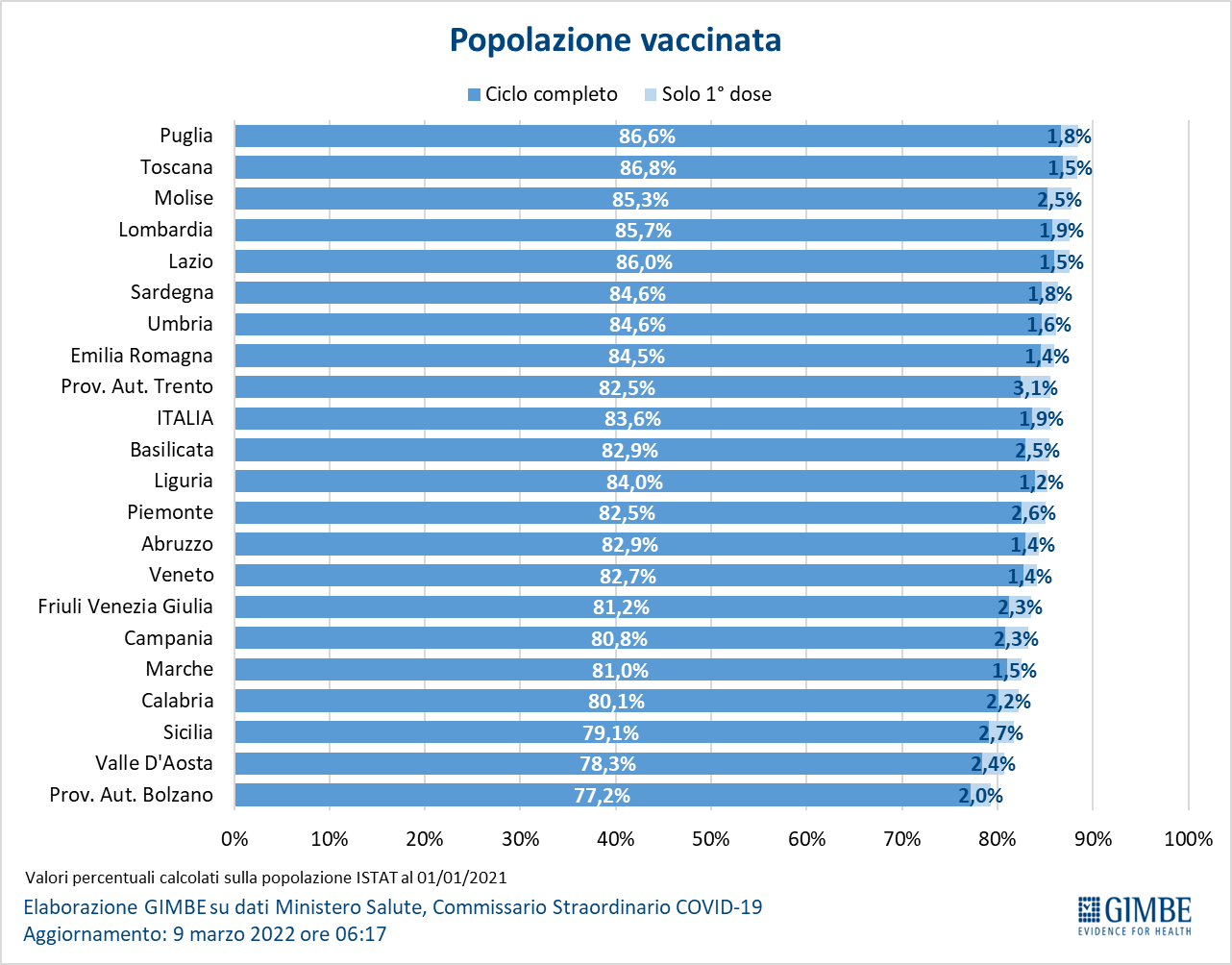
The number of administrations (n. 515,200) still decreased in the last week, with a 7-day moving average of 73,600 administrations / day: the third doses (n. 341,373) and 24.5 were reduced by 32.8% % new vaccinated people (29,474).
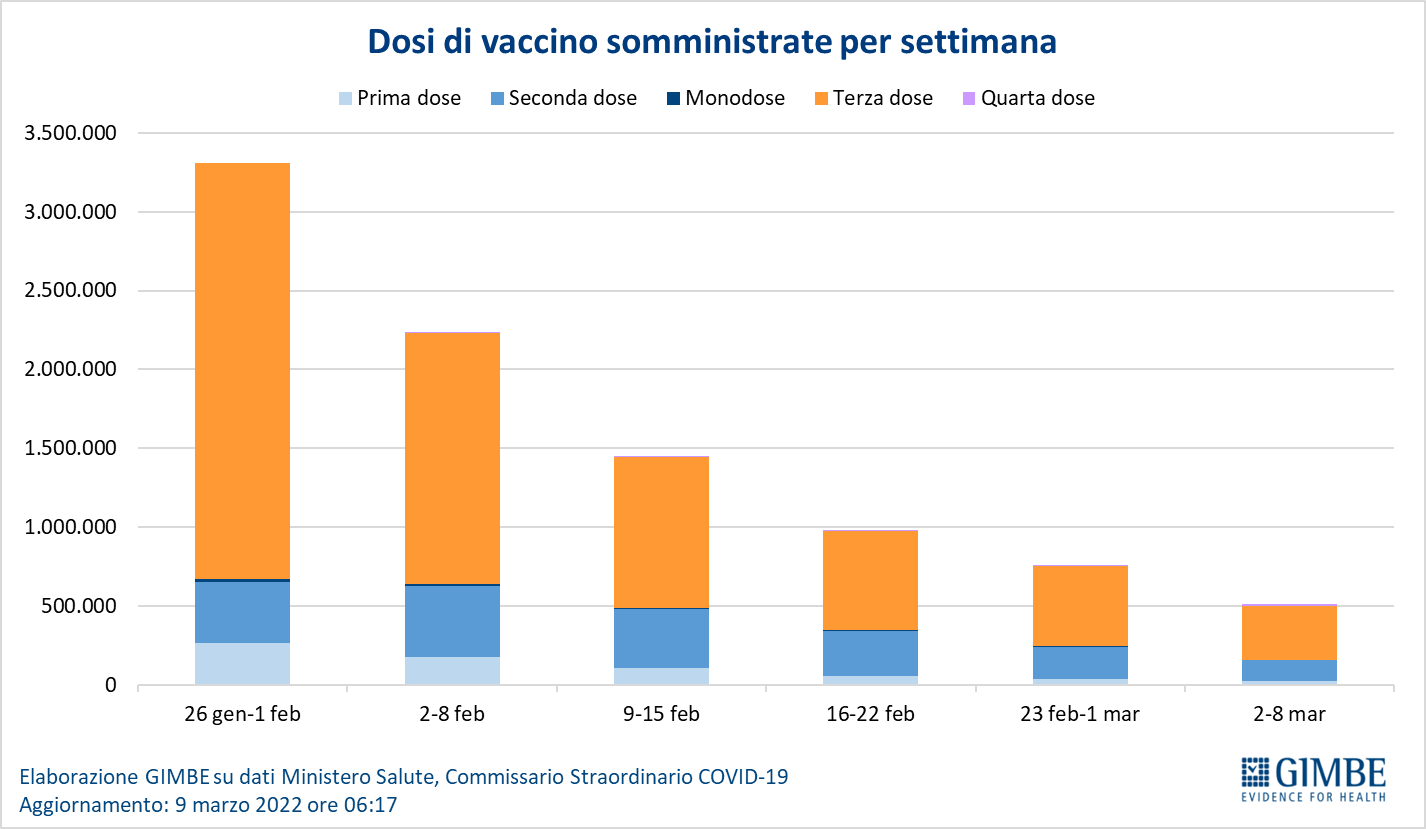
HOW MANY ARE STILL UNVACCINATED
As of March 9, there were 7.01 million people who have not received even a dose of the vaccine, of which 2.34 million recovered from COVID-19 for less than 180 days and therefore temporarily protected: the people currently vaccinated are therefore about 4, 67 million, a figure that does not take into account the exemptions of which the exact number is not known.
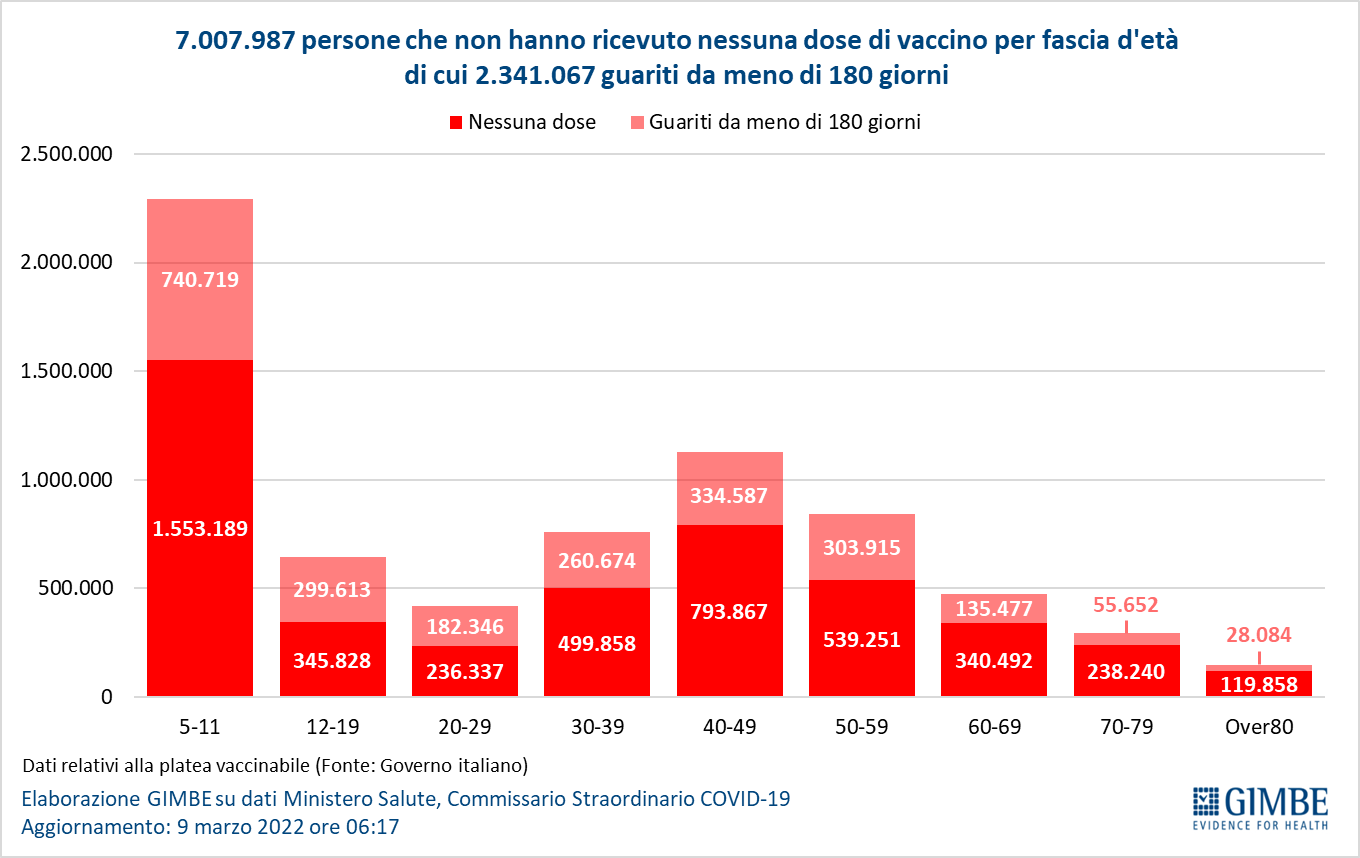
FOCUS VACCINATION OF CHILDREN
As of March 9, 2,373,493 doses have been administered in the 5-11 age group: 1,362,161 have received at least 1 dose of vaccine (of which 1,186,667 have completed the vaccination cycle), with a national coverage rate that stands at 37.1% with clear regional differences (from 20.1% of the Autonomous Province of Bolzano to 53.5% of Puglia).
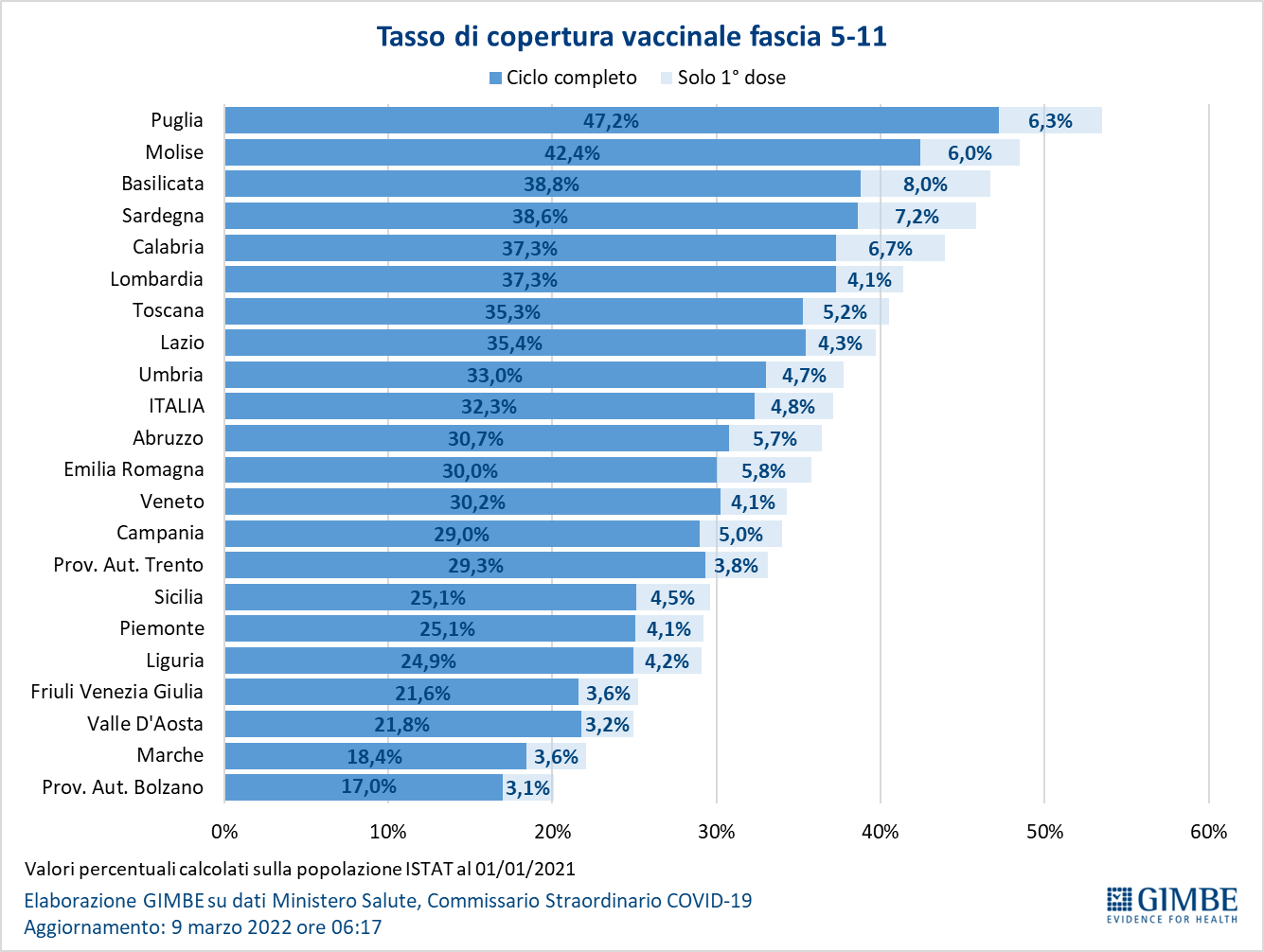
THIRD AND FOURTH DOSES
As of March 9, 37,938,907 third doses were administered with a 7-day moving average of 48,768 doses / day. According to the official audience (no. 45.820.994), updated to 4 March, the national coverage rate for third doses is 83% with clear regional differences: from 77% in Sicily to 86.7% in the Valley D'Aosta.
Of the 7,882,087 people who have not yet received the booster dose, more than 2.8 million could receive it immediately, while the more than 4.5 million recovered for less than 4 months are not candidates to receive it immediately.
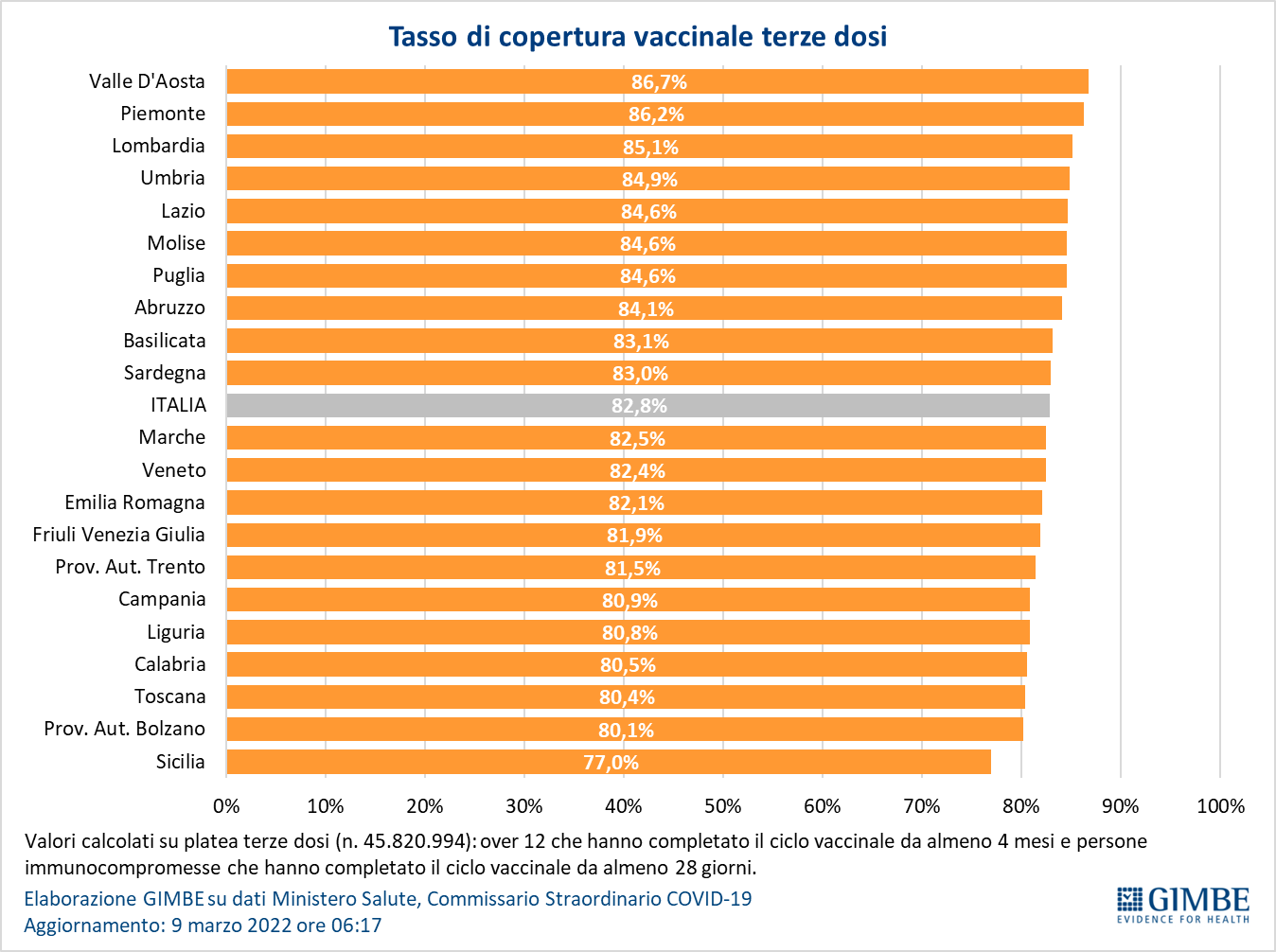
As of March 9, 18,973 fourth doses have been administered, currently indicated for immunocompromised people who have completed the primary course with three doses. According to the official audience (n.804.603), updated on 1 March, the national coverage rate for the fourth doses is 2.4%, also in this case with clear regional differences: from 0% in the Autonomous Province of Bolzano and Basilicata to 14.9% of Piedmont.
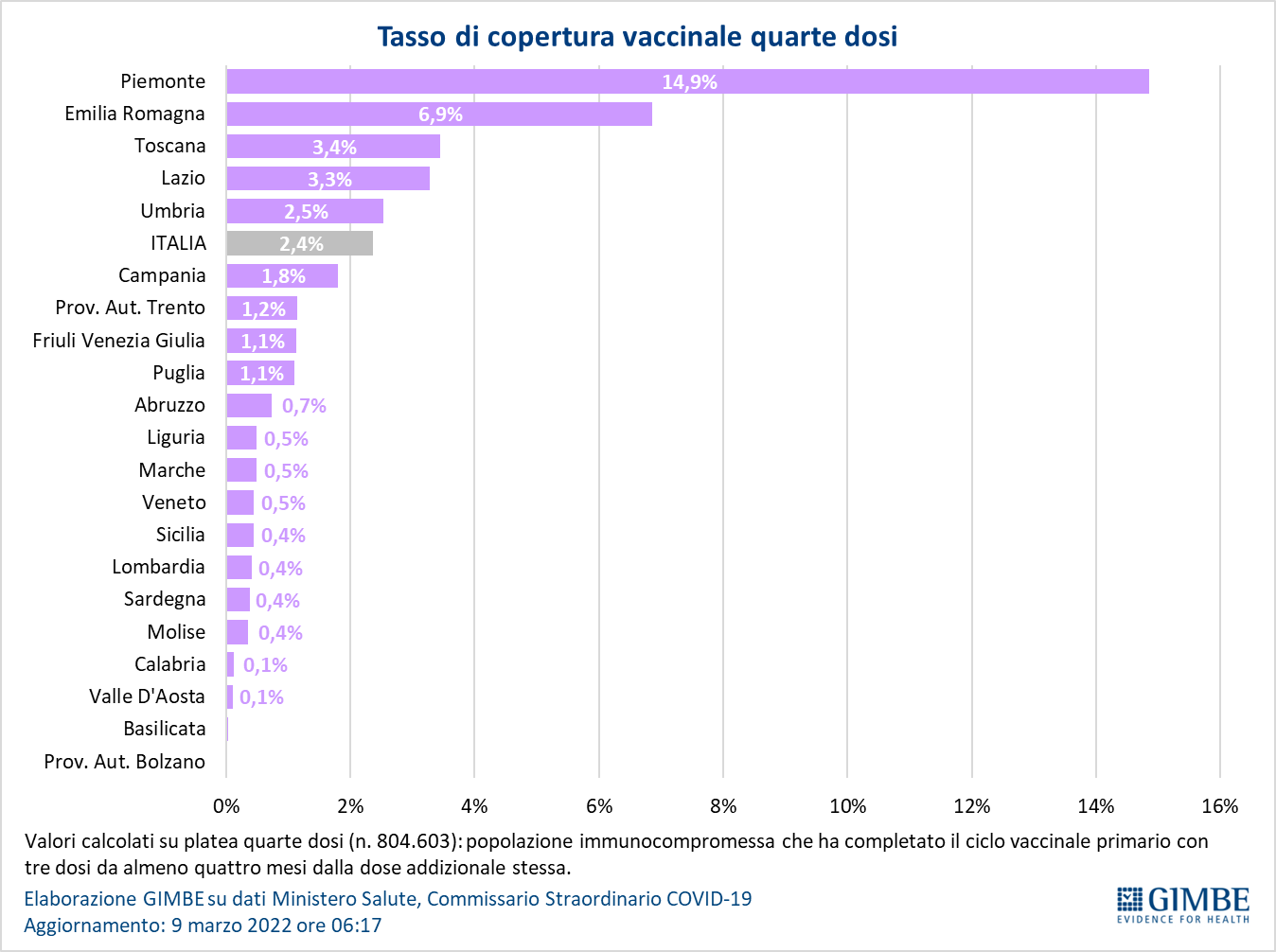
COVERAGE OF VACCINES
Coverage with at least one dose of vaccine is highly variable in the different age groups (from 99.3% of the over 80s to 37.1% of the 5-11 group), as well as in terms of recalls, which in the over 80s have reached 88.5%, 87.2% in the 70-79 age group and 83.7% in the 60-69 age group.
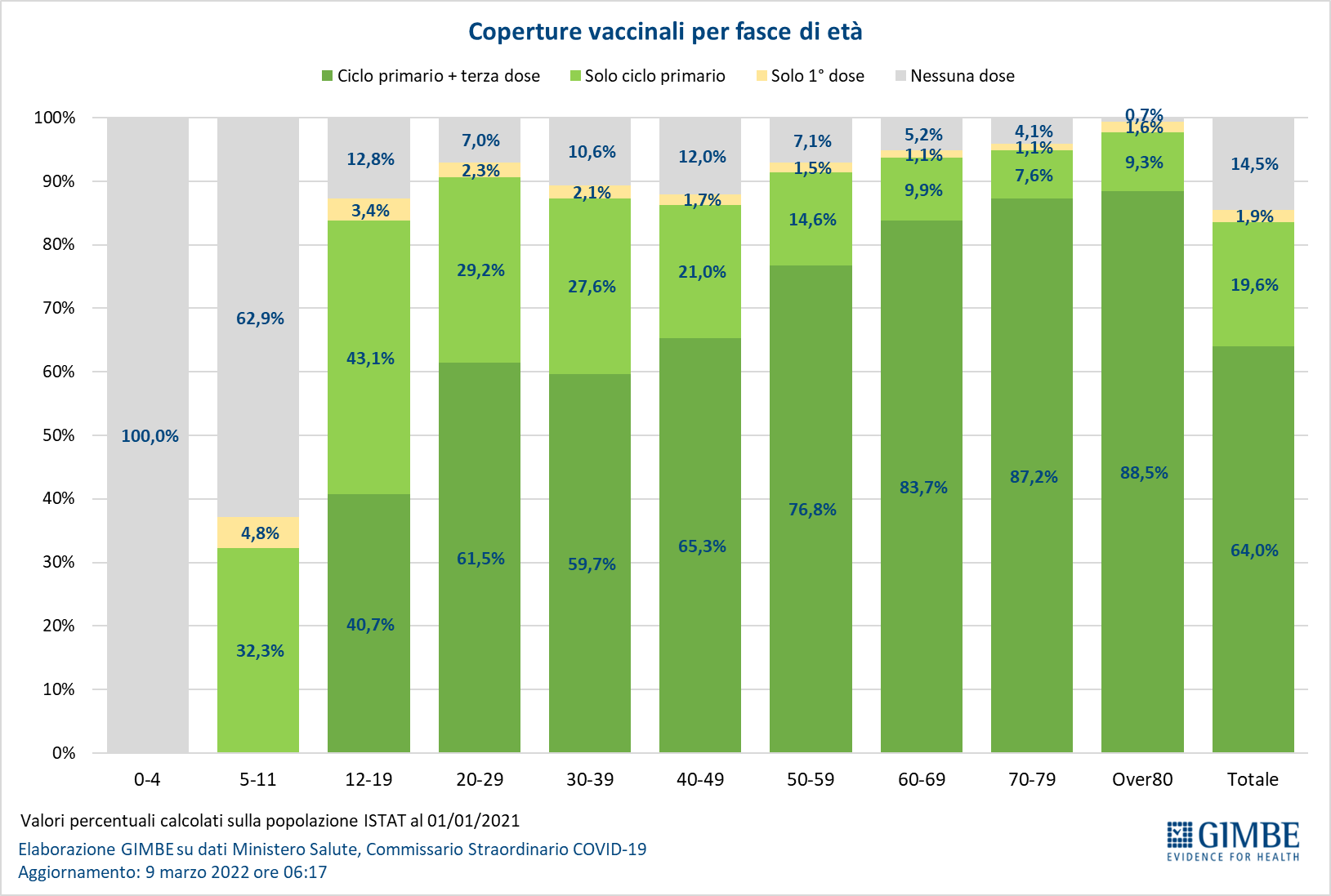
VACCINE EFFECTIVENESS
Data from the Istituto Superiore di Sanità demonstrate the reduction in vaccination efficacy starting from 3 months after the completion of the primary cycle and its recovery after the booster is administered.
In particular: the efficacy on diagnosis decreases progressively from 63% for vaccinated with two doses within 90 days to 43.6% for vaccinated for more than 120 days, to then rise again to 62.5% after the booster; the efficacy on severe disease progressively drops from 85.1% for those vaccinated with two doses within 90 days to 82.1% for those vaccinated for more than 120 days, and then rises to 92.2% after the booster.
Overall, in people vaccinated with a complete cycle (plus any booster dose), compared to those not vaccinated, the incidence of diagnosis is reduced in the various age groups (by 58.2-76.2%), but above all of disease severe (73.6-88.3% for ordinary hospitalizations; 78.1-91.7% for intensive care) and death (78.7-90.4%).
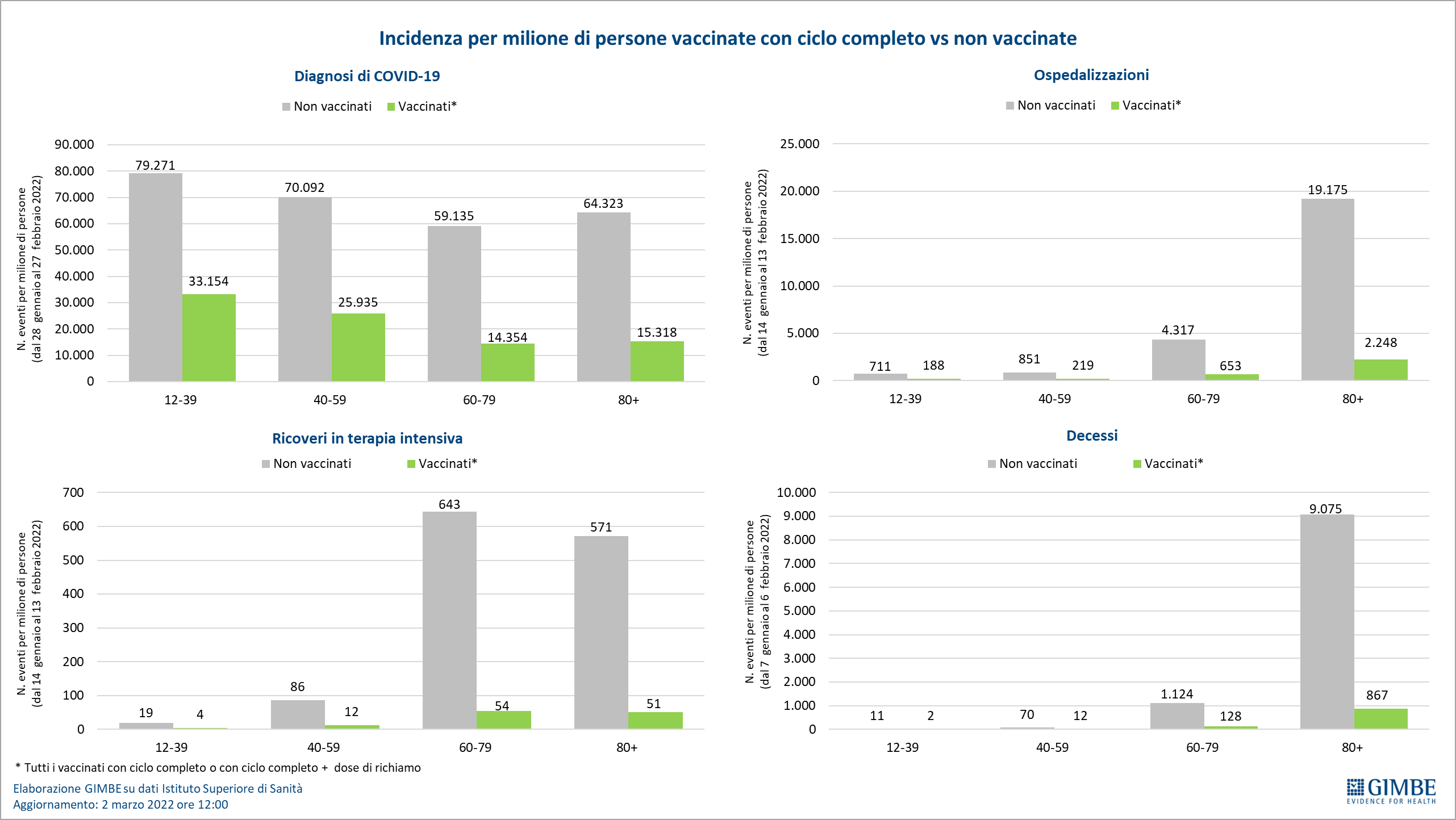
HOW DOES THE PANDEMIC GO IN ITALY?
Gimbe monitoring revealed in the week 2-8 March 2022, compared to the previous one, a slight increase in new cases (279.555 vs 275.376) (figure 1) and a decrease in deaths (1.201 vs 1.488) (figure 2).
Currently positive cases are also decreasing (1,011,521 vs 1,073,230), people in home isolation (1,002,153 vs 1,062,066), hospitalizations with symptoms (8,776 vs 10,456) and intensive care (592 vs 708) (figure 3).
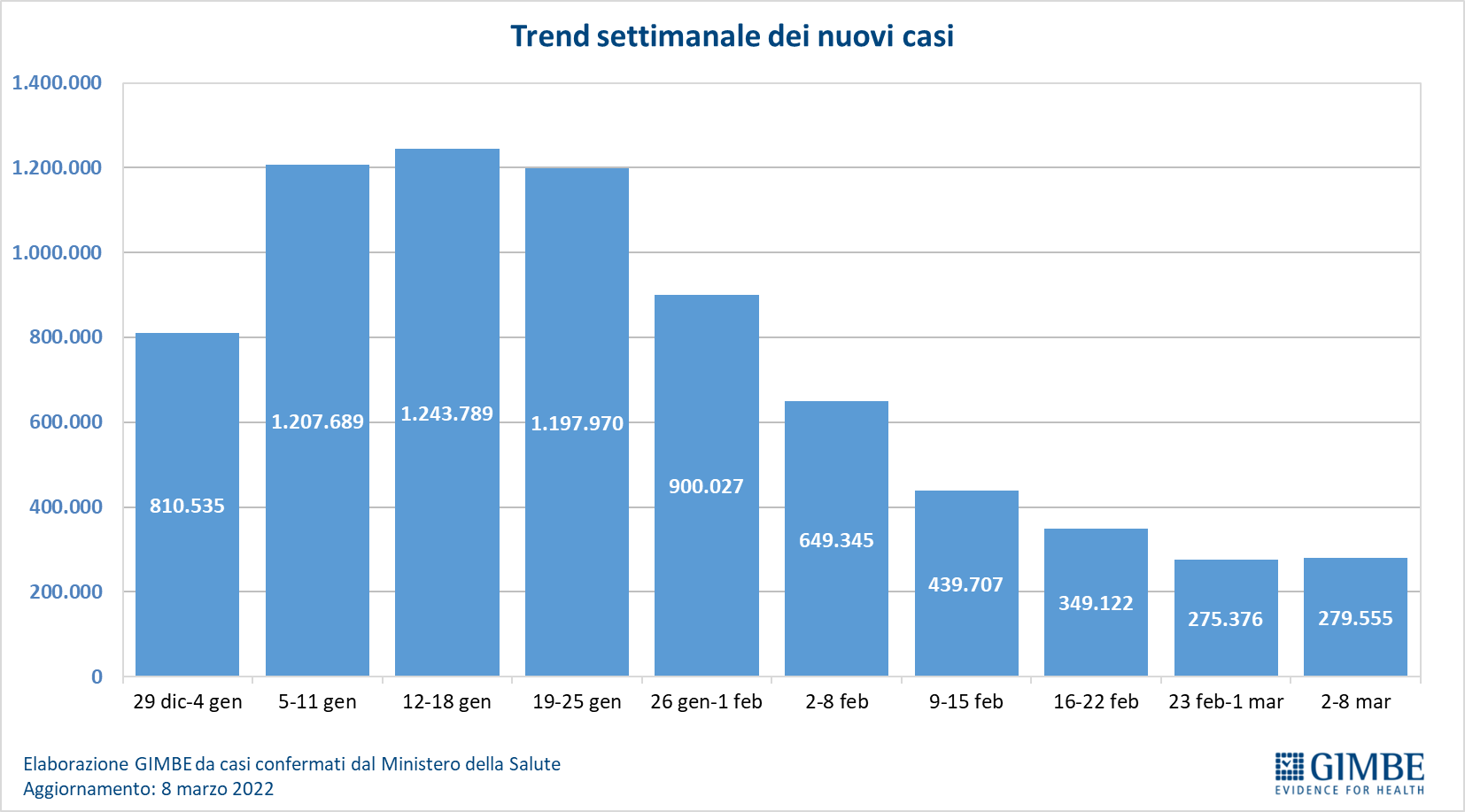
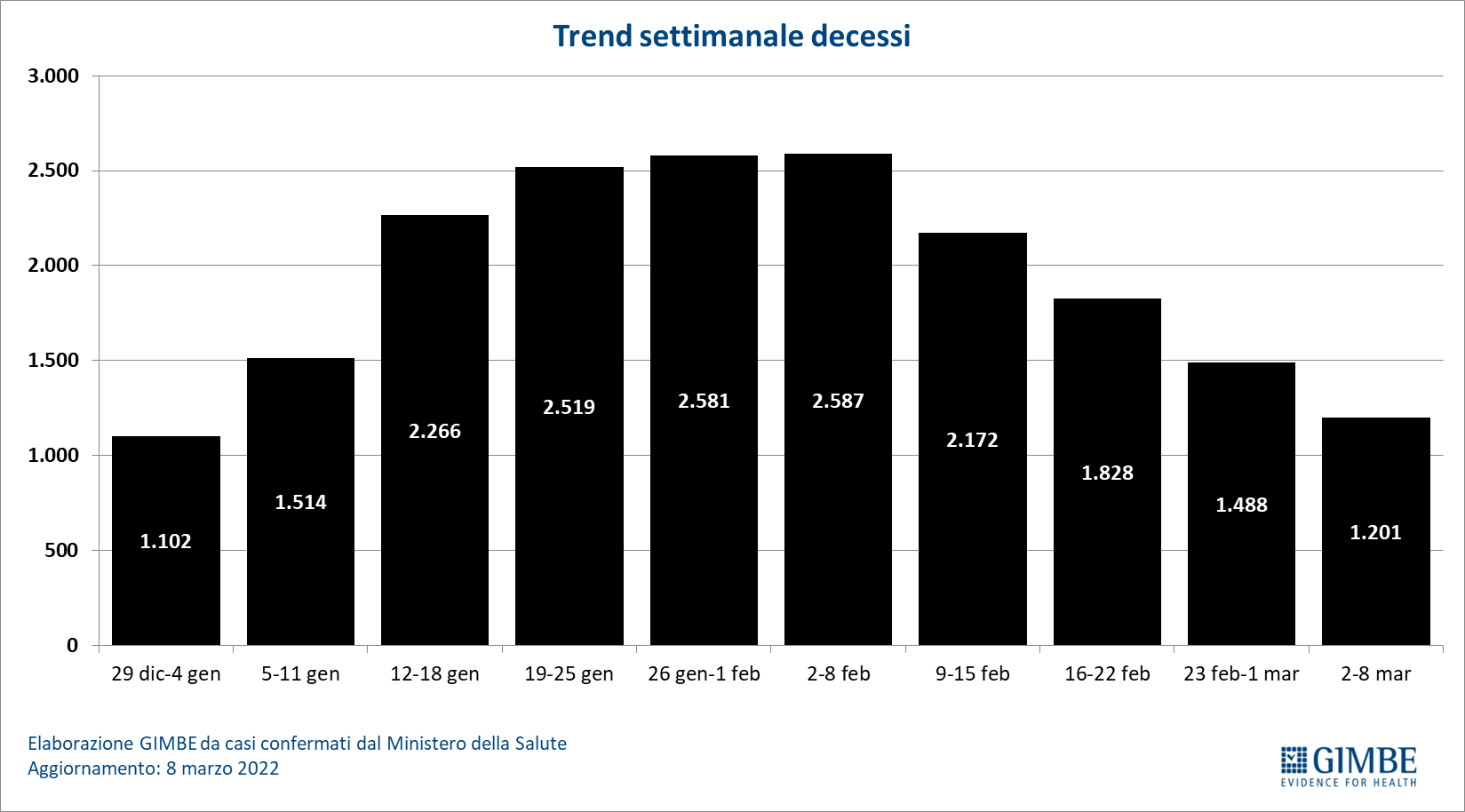
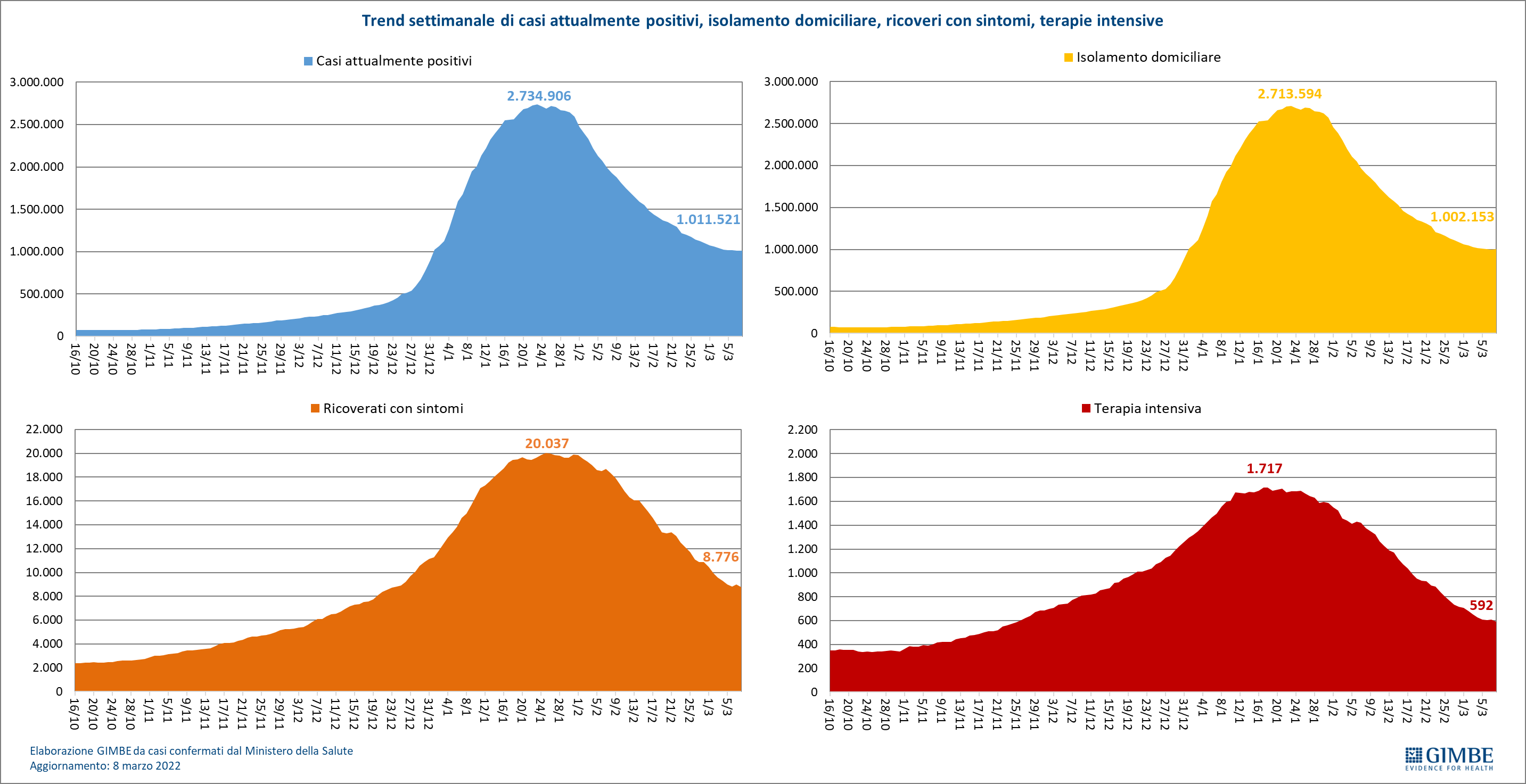
NEW CASES
“After five weeks – declared Cartabellotta – the decline of new weekly cases stops, despite a drop in the number of tampons of 8.8% compared to the previous week. The new cases amounted to around 279 thousand, with an increase of 1.5% and a 7-day moving average which rose from 39,339 cases on 1 March to 39,936 on 8 March (+ 5.8%) ".
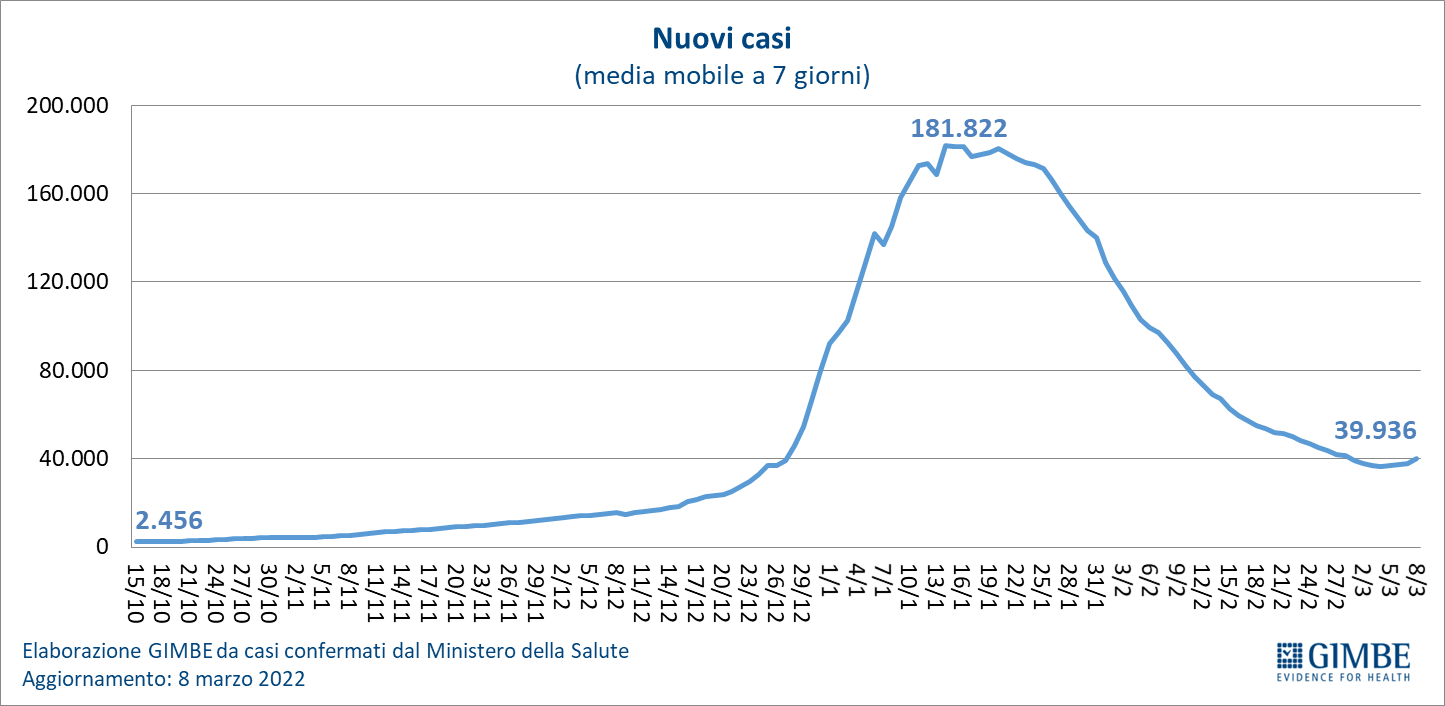
In the week 2-8 March there was a percentage increase in new cases in 12 Regions and a reduction in 9: from + 37.4% in Umbria to -12.7% in Lazio.
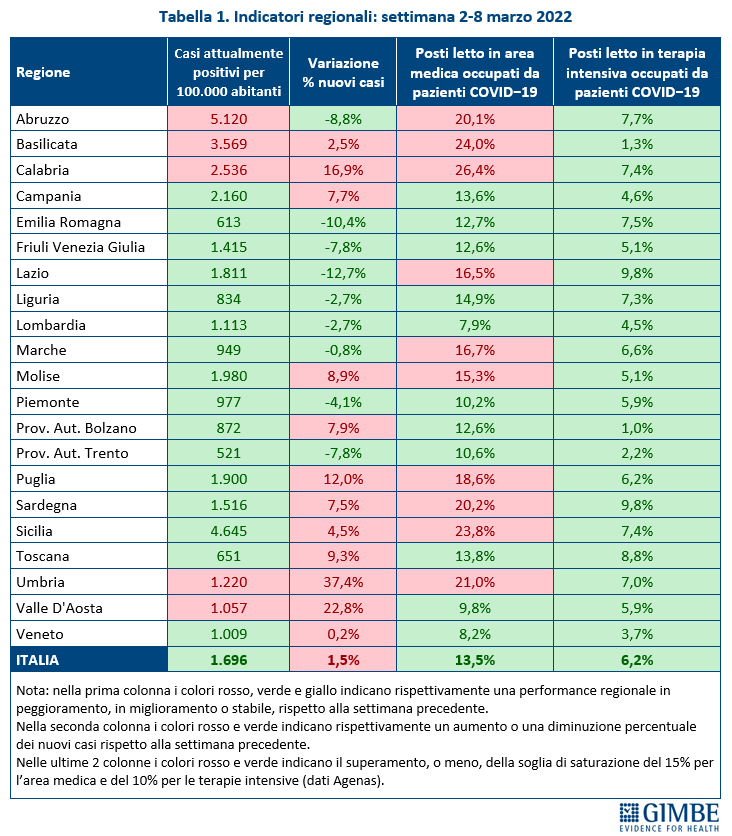
In almost half of the Provinces (49) there is a percentage increase in new cases compared to the previous week. The provinces with an incidence exceeding 500 cases per 100,000 inhabitants rose from 42 to 48: Lecce (1,035), Agrigento (924), Reggio di Calabria (920), Messina (906), Ragusa (859), Vibo Valentia (849), Trapani (842), Perugia (815), Ascoli Piceno (795), Fermo (763), Grosseto (737), Oristano (735), Matera (735), Siena (717), Terni (716), Syracuse (704) , Bolzano (675), Crotone (669), Sassari (668), Lucca (668), Campobasso (645), Arezzo (636), Macerata (634), Ancona (633), Enna (633), Palermo (633) , Venice (632), Cosenza (631), Benevento (630), Caltanissetta (629), Livorno (582), Foggia (579), Padua (568), Chieti (564), Caserta (563), Rieti (560) , Bari (559), Isernia (559), Frosinone (559), L'Aquila (556), Latina (555), Massa Carrara (553), Teramo (550), Potenza (548), Avellino (546), Cagliari (518), Taranto (518) and Pescara (516).

HOW ARE NEW CASES INCREASING?
"The recent increase in new cases – explained Cartabellotta – probably results from the interaction of various factors: relaxation of the population, spread of the more contagious variant Omicron BA.2 , persistence of low temperatures that force indoor activities, likely drop in protection vaccination against infection a few months after the booster dose. In any case, beyond the reasons, the data show that the circulation of the virus is still very high: almost 40,000 new cases per day, over 1 million positives and a positive rate of swabs of 11.4% " .
"ABANDONING THE MASKS IN CLOSURE IS MADNESS"
For the president of the Foundation “it will take 7-10 days to understand if the rise of the curve coincides with the beginning of a new wave, with subsequent impact on hospitals, or if it is simply a simple rebound. In the meantime, regardless of the expiration of the state of emergency, it is pure folly to think of abandoning the use of masks indoors, essential to contain the transmission of the infection as much as possible, also given the limited effectiveness of the vaccine in reducing the risk of infection " .
HOSPITALIZATIONS
"On the hospital front – says Renata Gili, Head of Research on Health Services of the Foundation – the number of beds occupied by COVID patients is further decreasing both in the medical area (-16.1%) and in intensive care (-16.4%)" . In particular, in the critical area from the peak of 1,717 on January 17th, hospitalizations fell to 592 on March 8th; in the medical area from the peak of 19,913 on January 31 to 8,776 on March 8.
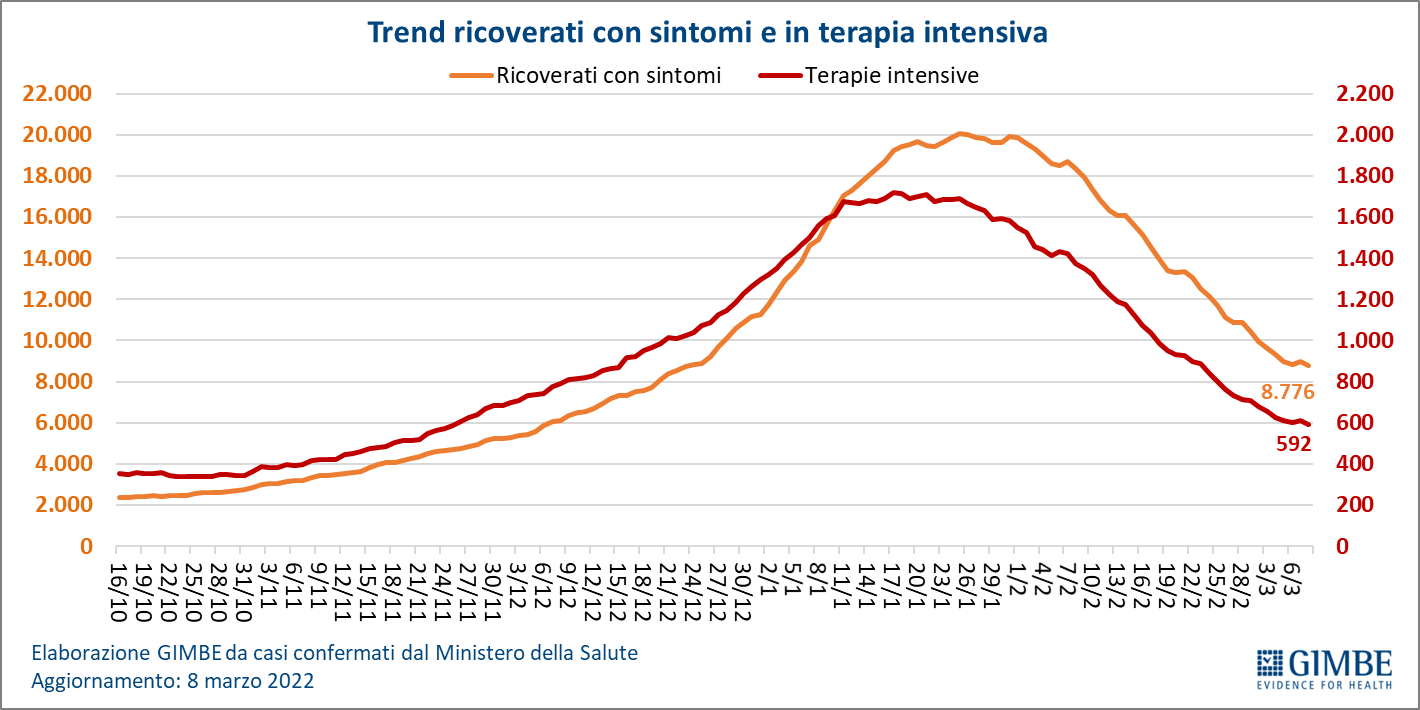
As of March 8, the national employment rate for COVID patients was 13.5% in the medical area and 6.2% in the critical area. Abruzzo, Basilicata, Calabria, Lazio, Marche, Molise, Puglia, Sardinia, Sicily and Umbria exceed the 15% threshold in the medical area; no Region goes beyond the 10% threshold in a critical area.
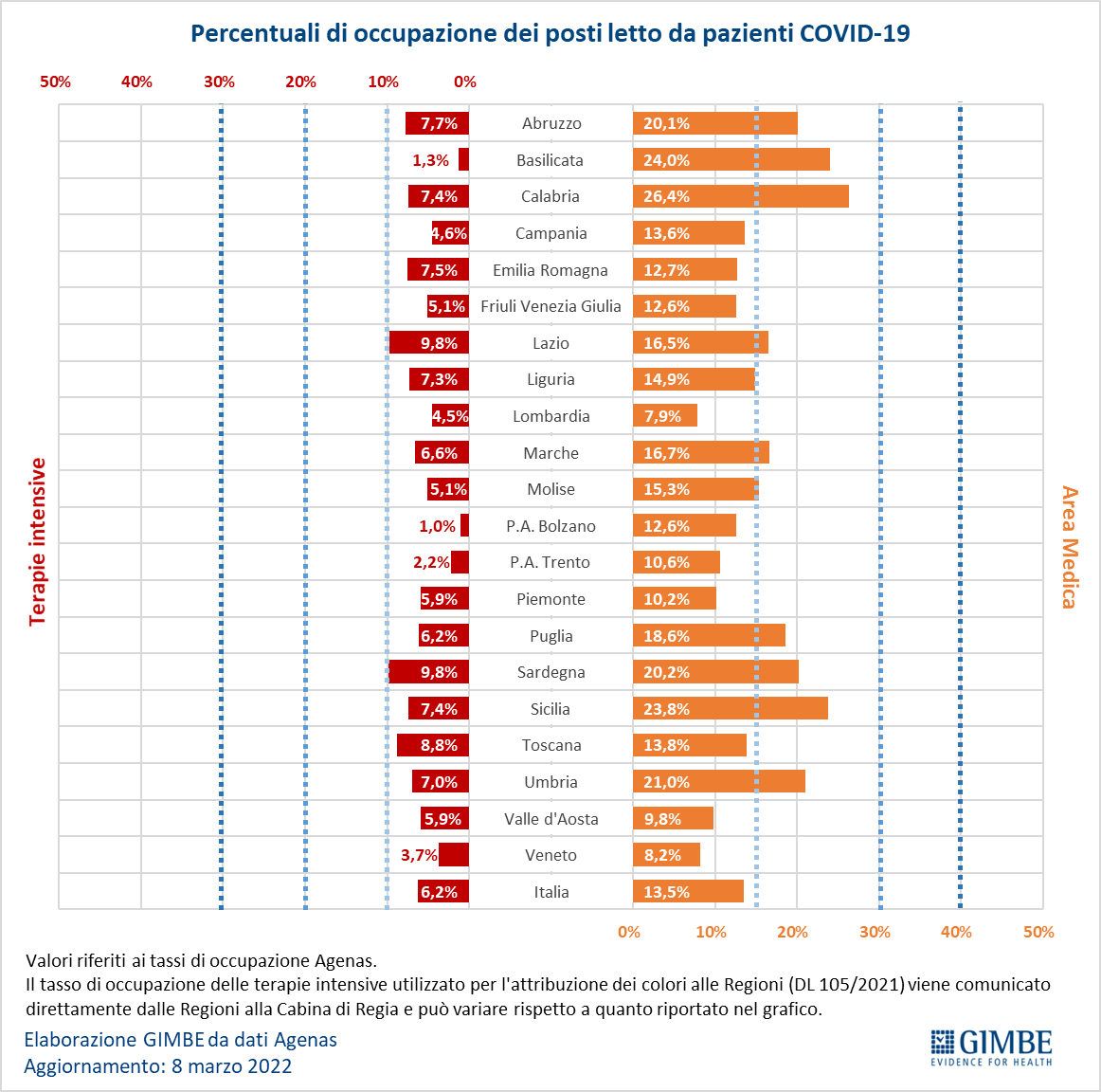
“A further reduction in daily admissions to intensive care is confirmed – points out Marco Mosti, Operational Director of the Foundation – whose 7-day moving average drops to 43 admissions / day compared to 54 in the previous week”.
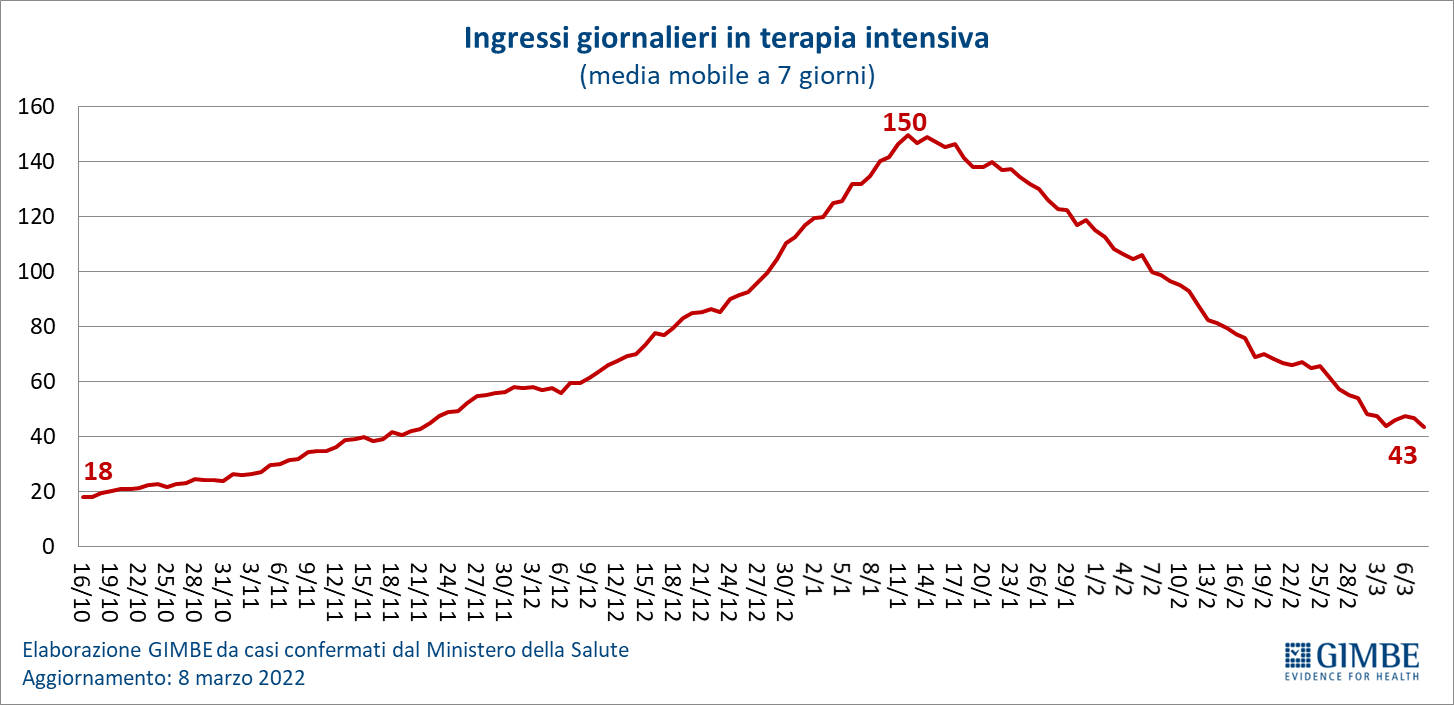
This is a machine translation from Italian language of a post published on Start Magazine at the URL https://www.startmag.it/sanita/novavax-nessun-boom-di-nuovi-vaccinati-report-gimbe/ on Thu, 10 Mar 2022 14:46:07 +0000.
